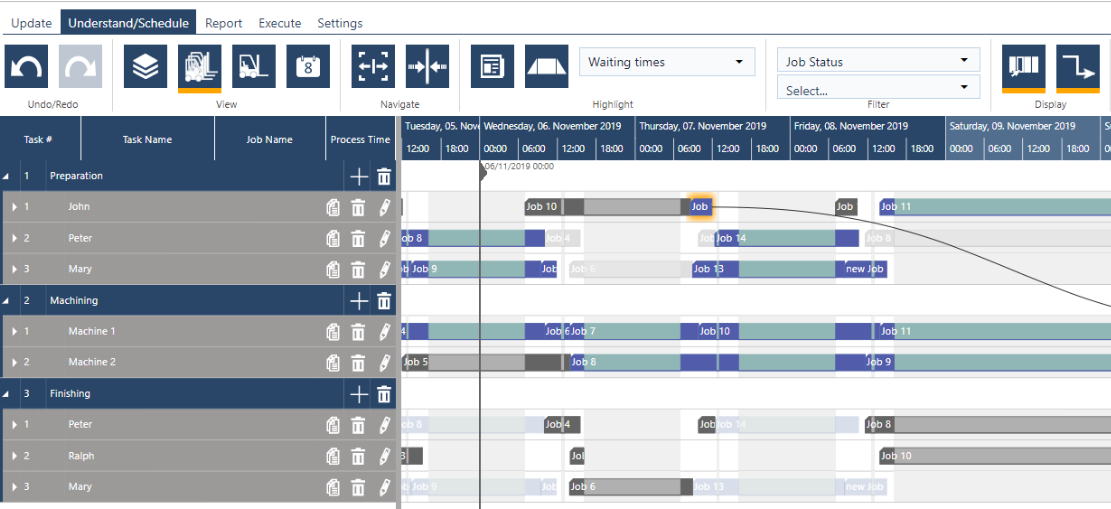Job shop scheduling is complex.
It's important therefore to sometimes stop, take a moment, and reevaluate things at a more basic level.
This blog post explores four of the most common scheduling challenges faced by small job shops today while also considering strategies to cope with these challenges.
 Challenges occur every day in life and are critical to growth. They allow us to assess what works and what doesn't and more, how to improve.
Challenges occur every day in life and are critical to growth. They allow us to assess what works and what doesn't and more, how to improve.
When it comes to scheduling in your job shop or small make-to-order business, these are four common challenges often pop up.
We also talk about job shop scheduling challenges in our webinars. Save your free seat.
Job Shop Scheduling Challenge 1: Data Transfer
Data directly drives action. In a job shop, it's critical to understand what needs to be done, how long it will take, and who can do it. In short, the jobs, tasks involved to complete said jobs, and resources required to get the jobs done.
Consistent and safe transfer of this core data to a schedule is the foundation of effective scheduling.
Therefore, one of the challenges faced by job shops and SMBs today is getting core data from a central collection system into a scheduling tool.
Data transfer means taking data, such as job tasks to be completed, resources, resource capacities and calendars, etc., and uploading them to the schedule as easily, safely, and consistently as possible. Minimization of data re-entry, i.e. entering a second or third time data such as job duration or job routings (series of tasks to be done in order to complete the job), as well as reduction of clicks are key factors.
The data transfer piece can be broken down into two parts:
- Part 1) Initial data transfer (usually the first upload of data into the schedule which establishes the baseline of resources, tasks involved to complete given jobs, and the current list of jobs themselves).
- Part 2) Ongoing updates. After the initial data transfer has been made a schedule is generated, changes such as sick personnel or maintenance on machines (unforeseeable alterations) must be taken into account as well. This results in an ongoing update schedule (such as a daily data transfer taking into account current circumstances) which gives you the most accurate schedule.
Visual Scheduling's Answer: Upload, create & edit jobs, tasks & resources in the same place where you plan
A great way to keep data updated is to have a scheduling tool, like
just plan it, which allows for easy data upload. This mean less manual entry and more integration between tools like excel and the visual scheduling board where the magic really happens.
What's more, not only should the tool allow for easy upload but also:
- ability to easily edit jobs and tasks once uploaded
- dialogues which can be quickly understood in the context of the small job shop work environment
- ERP interfacing (when applicable)
Job Shop Scheduling Challenge 2: Understanding the Schedule
Once data is able to adequately and effectively be transferred from your data collection application (i.e. excel, ERP, etc.), the next challenge is to work toward understanding.
Understanding your data means a few things.
- having your data in one coherent place
- the ability to sift and filter down through the data
- realizing (& seeing), in real-time, the causality between events (i.e. if production order A is pushed out, how will it impact the rest of the following production orders.)
Visual Scheduling's Answer: See your call(s) to action in a Gantt chart
Utilizing a Gantt chart for visualizing time and resource-oriented data allows for easier understanding. Beyond centralizing data, the ability to filter, and realizing causality in real-time, it brings:
- Multiple views and perspectives (jobs view & resource view)
- Various filter options
- Multiple color schemes
All features which support the act of understanding the schedule. Understanding is critical as it will form basis of what is often the next challenge, scheduling effectively.
Job Shop Scheduling Challenge 3: Easier Scheduling
Now that the right data is being used and the right tools are there to understand it, another challenge which can arise is scheduling. The challenge here includes moving items around in your schedule and seeing the impact of the changes made (in real time).
The aspect of scheduling effectively goes hand in hand with the preceding two points of the article. In fact, you can think about
Visual Scheduling's Answer: Schedule based on your call to action
Your business needs to remain flexible and the same is true for your schedule. A tool which can support multiple types of scheduling is key.
This brings to light one of the misunderstood advantages of visual scheduling. Namely, the automating of certain actions and the manual control of others, or the ability to combine manual and automatic into hybrid scheduling.
You won't get such support from basic excel and you won't get such agility from advanced planning solutions who rely heavily on big investments in high data quality to generate an optimized schedule.
The bottom line, keeping data up-to-date and understanding it all does little unless you can schedule with it and that means:
- Manual Scheduling
- Automatic Scheduling
- Hybrid Scheduling
Job Shop Scheduling Challenge 4: The Balance Between Reporting & Scheduling
Sometimes having a strong schedule does not always mean having a strong report. The quality of the two do not always go hand in hand even though one often plays an influential role in the others' success.
Scheduling is a forward-facing function. This means looking at upcoming and figuring out the best schedule. Reporting however, is a backward-facing function in which the past is looked at to see what went well and what could have been better.
Though the two look in fundamentally different directions, do they need to live as separate entities?
Visual Scheduling's Answer: Retrieve reports of your new schedule
Scheduling and reporting are not the same but that does not mean they need to be strangers to one another. By combining the two, insights can be gained.
Reporting from the schedule can translate over into many things, including:
- Job & Task Reporting
- Baseline vs. Actual results on the schedule
- Capacity Report
- A complete glimpse of capacity utilization across the schedule
And beyond this, reporting on quality data feeds back into creating and maintaining high quality data for the input. This creates a cycle of repeating data quality throughout your scheduling process which means execution on in a way you know will work.
Bringing it all together in a job shop scheduling software
The world is evolving and with it our technologies and understanding of many things. This includes scheduling processes in small job shops all over the globe.
Our clients are job shops from all parts of the world that had to face the challenges, I talk about in this post. Challenges in scheduling often start when business grows. Scheduling problems implicate a higher risk of failed delivery dates, less customer satisfaction, unused capacities and the risk, to become outstripped by their competition.
We developed our scheduling software just plan it especially for small job shops. Want to learn how it can help solving your job shop scheduling challenges? Schedule a free one-to-one consultation with on of our scheduling experts.

We are also looking forward to hear about your challenges of job shop scheduling in our comments section below!
Further Reading

 Challenges occur every day in life and are critical to growth. They allow us to assess what works and what doesn't and more, how to improve.
Challenges occur every day in life and are critical to growth. They allow us to assess what works and what doesn't and more, how to improve. 
No Comments Yet
Let us know what you think